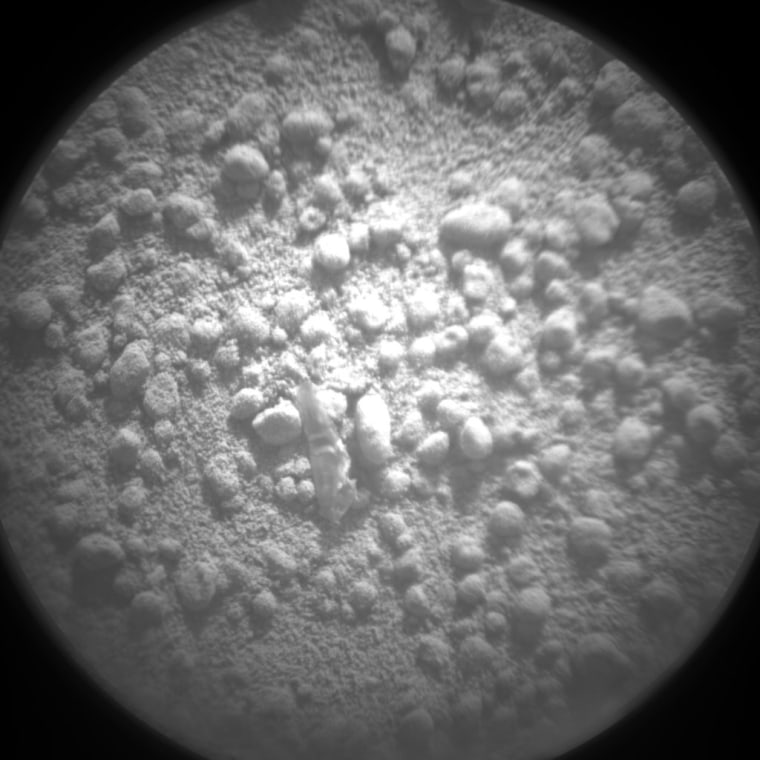A tiny, bright object that was spotted on the Martian surface next to the Curiosity rover appears to be a shred of plastic from the rover itself, NASA reported today.
That assessment, based on an analysis of imagery from the rover's ChemCam micro-imager, echoes the speculation that bubbled up around Twitter (and in Cosmic Log) on Monday. If further investigation confirms the experts' preliminary conclusion, Curiosity should be able to give the shred wide berth and proceed with its scooping activity at a spot known as Rocknest.
Curiosity's scoop had just picked up a full load of soil from Rocknest's sand dune and was shaking it around when the rover team noticed the bright little fleck. Team members decided to hold up on processing the sample until they could identify the object. They want to make sure they won't be putting any contaminants (such as plastic trash) into the rover's sensitive sampling system.
It's not unusual for rovers to spot bits of hardware or other spacecraft debris in their surroundings. Past examples include Opportunity's "bunny ears" (a bit of fabric) and "rover rotini" (an artifact created by the rover's drill), as well as a spring that was dropped onto the surface by the Phoenix Mars Lander. It looks as if Curiosity's shred will join that collection. As we noted on Monday, lots of plastic tape is used on the rover to insulate wiring, and it's likely that a tiny bit of it was shaken loose.
Here's the mission status report from NASA. If there's a follow-up report on the object, I'll add it to this item:
"Curiosity's main activity in the 62nd sol of the mission (Oct. 8, 2012) was to image a small, bright object on the ground using the Remote Micro-Imager of the Chemistry and Camera (ChemCam) instrument.
"The rover team's assessment is that the bright object is something from the rover, not Martian material. It appears to be a shred of plastic material, likely benign, but it has not been definitively identified.
"To proceed cautiously, the team is continuing the investigation for another day before deciding whether to resume processing of the sample in the scoop. Plans include imaging of surroundings with the Mastcam.
"A sample of sand and dust scooped up on Sol 61 remains in the scoop. Plans to transfer it from the scoop into other chambers of the sample-processing device were postponed as a precaution during planning for Sol 62 after the small, bright object was detected in an image from the Mast Camera (Mastcam).
"A Sol 62 raw image from ChemCam, at http://1.usa.gov/R1fZHt, shows the object in question just to left of center of the image...."
Update for 8:15 p.m. ET Oct. 10: For the record, NASA is sticking with the plastic-scrap explanation, and Curiosity's robotic arm is back in action. There's an interesting twist to the story: Experts think that the scrap may have fallen onto the rover from the rocket-powered descent stage, which set Curiosity down on the surface at the end of the "seven minutes of terror" on Aug. 5. Then the scrap fell off the rover at Rocknest. Here's today's update from the team:
"The team operating Curiosity decided on Oct. 9, 2012, to proceed with using the rover's first scoop of Martian material. Plans for Sol 64 (Oct. 10) call for shifting the scoopful of sand and dust into the mechanism for sieving and portioning samples, and vibrating it vigorously to clean internal surfaces of the mechanism. This first scooped sample, and the second one, will be discarded after use, since they are only being used for the cleaning process. Subsequent samples scooped from the same 'Rocknest' area will be delivered to analytical instruments.
"Investigation of a small, bright object thought to have come from the rover may resume between the first and second scoop. Over the past two sols, with rover arm activities on hold, the team has assessed the object as likely to be some type of plastic wrapper material, such as a tube used around a wire, possibly having fallen onto the rover from the Mars Science Laboratory spacecraft's descent stage during the landing in August.
"Sol 63 activities included extended weather measurements by the Rover Environmental Monitoring Station, or REMS. The Sol 63 planning also called for panoramic imaging by the Mast Camera, or Mastcam, in the early morning light of Sol 64, before uplink of Sol 64 commands.
"A Sol 61 raw image from the right Mast Camera, at http://1.usa.gov/VSwTN7 , shows the location from which Curiosity's first scoop of soil was collected.
"Sol 63, in Mars local mean solar time at Gale Crater, ended at 1:03 a.m. Oct. 10, PDT (4:03 a.m., EDT)."
More about Mars:
- Weird object gives Curiosity pause
- Mars rover gets set for its first scoop
- Curiosity rover 'checks in ' to Foursquare
- Curiosity is driving through dried-up riverbed
Alan Boyle is NBCNews.com's science editor. Connect with the Cosmic Log community by "liking" the log's Facebook page, following @b0yle on Twitter and adding the Cosmic Log page to your Google+ presence. To keep up with Cosmic Log as well as NBCNews.com's other stories about science and space, sign up for the Tech & Science newsletter, delivered to your email in-box every weekday. You can also check out "The Case for Pluto," my book about the controversial dwarf planet and the search for new worlds.
